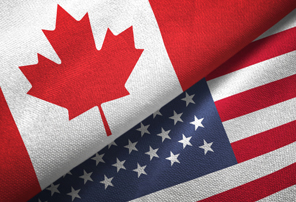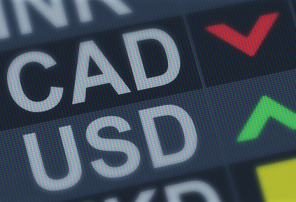What to Know About Having a Canadian and U.S. Side to Your Account
Published on November 12, 2021
minute read
Share:
We answer your frequently asked questions about having a Canadian and a U.S. side to your account.
In which accounts do I have a U.S. dollar side?
Most accounts have a U.S. side where you can conveniently hold U.S. dollars and U.S. securities, including:
- Tax-Free Savings Accounts (TFSAs)
- Registered Retirement Savings Plans (RRSPs)
- Group RRSPs
- Registered Retirement Income Funds (RRIFs)
- Life Income Funds (LIFs)
- Locked-in Retirement Income Funds (LRIFs)
- Prescribed Retirement Income Funds (PRIFs)
- Restricted Life Income Funds (RLIFs)
- Locked-in Retirement Accounts (LIRAs)
- Restricted Locked-in Savings Plans (RLSPs)
- Cash investment accounts
- Margin investment accounts
The only exception is Registered Education Savings Plans (RESPs), where a U.S. dollar account side is not available.
I currently have an RBC Direct Investing account; how can I hold U.S. dollars in my account?
As a client, you don't have to take any action to be able to hold U.S. dollars. The U.S. dollar side of the account is automatically available to you in all accounts, except RESPs. You can contribute new funds in real-time directly from an RBC U.S. dollar banking account, or you can make a conversion to buy U.S dollars if you already have funds in Canadian dollars, by going to Trade & Transfer > Transfers > Transfer Funds.
How can I open an RBC Direct Investing account where I can hold U.S. dollars?
The ability to hold U.S. dollars in your account is automatically available in all new and existing accounts, except RESPs.
How can I move my U.S. securities from the Canadian dollar side to the U.S. dollar side of my account?
If you would like your U.S. securities moved to the U.S. dollar side of the account, please contact us at 1-800-769-2560. Alternatively, send us a secure message with your instructions, including the account number, the name of the security and the quantity of the security you would like moved to the U.S. dollar side of your account.
Are negative cash balances in one currency offset by a positive cash balance in the other currency within the same account?
No, currency positions are treated separately within the same account. A negative cash balance (debit) in one currency is not offset by a positive cash balance (credit) in the other currency. Interest is charged and calculated separately for each currency that you hold in your account. In addition, Canadian tax rules prohibit registered plans from borrowing cash or maintaining an overdraft position at any time. When an overdraft is created, your registered plan may be considered to have borrowed. This may result in adverse tax consequences depending on the type of registered plan.
How are dividends for U.S. securities treated if they are held on the U.S. dollar side of the account?
Dividends are paid in U.S. dollars and not converted to Canadian dollars if the investment is held on the U.S. dollar side of the account. Dividends from U.S. companies can be subject to withholding taxes; the tax rate depends on the type of account and investment. The good news is that this tax rate can often be reduced as a result of U.S. statutory exemptions or provisions under a tax treaty with the U.S. To make certain that you are not paying any unnecessary taxes, complete the online W-8BEN Substitute Form for your account.
Am I able to hold U.S. dollars in Registered Education Savings Plans (RESPs)?
No. The ability to hold U.S. dollars is not available for RESPs .
Trading
How do I trade the securities on the U.S. dollar side of my account?
Each account displays both Canadian dollar (CAD) and U.S. dollar (USD) holdings. The account number dropdown menu on the Order Entry page lists each of your accounts followed by “CAD" and “USD." To settle a trade on the U.S. side of the account simply select your USD account and make sure to select U.S in the Market dropdown when placing an order.
I have a U.S. dollar security sitting on the Canadian side but I would like to have this security settle in U.S. dollars when it is sold. How do I do this?
You can sell the position on the U.S. dollar side by selecting the USD side of your account on the Order Entry page. The security that was sold may still appear temporarily on the Canadian dollar side of your account while the U.S. dollar side of your account shows a negative position. When your trade settles, both the Canadian dollar and U.S. dollar sides of your account will be automatically corrected.
Do I have to call in advance to avoid currency conversions when I trade U.S. securities in my accounts?
Because all accounts except RESPs have a U.S. dollar side, you don't need to call in with a special request to trade U.S. securities when you select the U.S. dollar side of the account.
Retirement Income Fund accounts
Are U.S. dollar payments from an income fund permitted?
Yes. To start receiving RIF/LIF payments in U.S. dollars please contact us by phone at 1-800-769-2560 or via secure email.
Is income fund unlocking available on the U.S. dollar side of the account?
Yes. To unlock income funds please contact us by phone at 1-800-769-2560 or via secure email.
Taxes and Fees
What are the tax implications of trading on the U.S. dollar side of a registered account?
With regard to trading in a tax-deferred or tax-free plan, the tax implications of any trade are the same in Canadian and U.S. dollars. Be aware that withholding taxes can apply to U.S. dividends paid from U.S. securities. A W-8BEN form can help reduce the taxes withheld.
Are additional trading commissions or fees applied if I choose to trade in U.S. dollars?
RBC Direct Investing does not charge any extra fees or transaction costs when you choose to settle in U.S. dollars. Our same trading commissions apply, applicable in the currency you are trading in. Please refer to the Commissions and Fees schedule.
Is there a single quarterly maintenance fee or one for each side of the account, Canadian and U.S.?
The two currency sides form a single account. At RBC Direct Investing, there is no maintenance fee1 if your combined assets are $15,000 or more across all of your RBC Direct Investing accounts. If y`our combined assets are less than $15,000 across all of your RBC Direct Investing accounts, you will be charged one maintenance fee of $25 CAD per quarter (split across all your accounts*). However, this fee can be waived for a number of other reasons. For full details please refer to the complete Commissions and Fees schedule.
*Clients can open a maximum of 10 accounts for a combined maintenance fee of $25/quarter. Additional maintenance fees will apply if a client has more than 10 accounts.
Contributions
Can I make a cash or in-kind contribution to my registered account in U.S. dollars?
Yes. The funds or securities you contribute will remain in U.S. dollars in your account, but the contribution receipt will reflect the Canadian dollar equivalent. Note that in-kind contributions in either currency are considered deemed dispositions for tax purposes (the Canada Revenue Agency treats the investments as sold, meaning you realize a capital gain or loss). Under normal circumstances any capital gain will have to be declared, but you may not claim any resulting capital loss. Please consult with a qualified tax advisor for more information.
Can I contribute to the U.S. dollar side of my registered account from my U.S. dollar RBC bank account?
Yes, you can contribute directly from your RBC U.S. dollar chequing or savings account into the U.S. dollar side of your registered account (excluding RESPs).
Withdrawals
How do U.S. dollar withdrawals work for Registered Retirement Savings Plans and Registered Retirement Income Funds (RRSPs and RRIFs)?
You can withdraw U.S. dollars from your RRSP and RRIF. Withholding taxes will be charged in U.S. dollars but reported in Canadian dollars using the previous day's average exchange rate. Withdrawal fees (if applicable) will be charged in U.S. dollars for RRSPs but in Canadian dollars for RRIFs.
Can I withdraw U.S. dollars for the purpose of the Home Buyers Plan or the Lifelong Learning Plan?
No. Withdrawals made as part of the Home Buyers Plan or the Lifelong Learning Plan are required to be in Canadian dollars.
Can I make a TFSA withdrawal in U.S. dollars from the U.S. dollar side of my account?
Yes, you can make a TFSA withdrawal in U.S. dollars.
Statements
How will I receive statements for the U.S. dollar side of my accounts?
One statement will be issued for the Canadian dollar side of your account and one for the U.S. dollar side, if you have U.S. dollar holdings or transactions. Statements are issued quarterly (March, June, September and December) regardless of activity. For all other months, a statement will be generated only if there was activity in the account.
Where can I see U.S. dollar contributions on my statement?
Your contribution summary appears on the first page of your Canadian dollar statement regardless of what side of the registered account (RRSPs & TFSAs) the contribution was made to. You will see the U.S. dollar contribution transaction on the U.S. dollar statement along with the exchange rate applied at the time.
Other
What are the Canada Revenue Agency (CRA) foreign content rules?
There are no foreign content limits on registered or non-registered accounts. Some U.S. securities traded on the over-the-counter market might not be eligible to be held in a registered account. Please contact us at 1-800-769-2560 or via secure message to confirm the eligibility of a security.
Can an in-kind RRSP withdrawal be done in U.S. dollars?
Yes, you can withdraw U.S. dollar holdings from your RRSP. For income tax purposes, the U.S. dollar value of the security will be converted to Canadian dollars before withholding tax is deducted. The previous day's average exchange rate is used to calculate the Canadian dollar value of the withdrawals.
The information provided in this article is for general purposes only and does not constitute personal financial or tax advice. Please consult with your own professional advisor to discuss your specific financial and tax needs.
RBC Direct Investing Inc. and Royal Bank of Canada are separate corporate entities which are affiliated. RBC Direct Investing Inc. is a wholly owned subsidiary of Royal Bank of Canada and is a Member of the Investment Industry Regulatory Organization of Canada and the Canadian Investor Protection Fund. Royal Bank of Canada and certain of its issuers are related to RBC Direct Investing Inc. RBC Direct Investing Inc. does not provide investment advice or recommendations regarding the purchase or sale of any securities. Investors are responsible for their own investment decisions. RBC Direct Investing is a business name used by RBC Direct Investing Inc. ® / ™ Trademark(s) of Royal Bank of Canada. RBC and Royal Bank are registered trademarks of Royal Bank of Canada. Used under licence.
© Royal Bank of Canada 2021.
1 There is no quarterly maintenance fee charged if your combined assets are $15,000 or more across all of your RBC Direct Investing accounts. If your combined assets are less than $15,000 across all of your RBC Direct Investing accounts, you will be charged one maintenance fee of $25 per quarter (split across all of your accounts). For full details please refer to the complete Commissions and Fees Schedule at www.rbcdirectinvesting.com/fees.
Any information, opinions or views provided in this document, including hyperlinks to the RBC Direct Investing Inc. website or the websites of its affiliates or third parties, are for your general information only, and are not intended to provide legal, investment, financial, accounting, tax or other professional advice. While information presented is believed to be factual and current, its accuracy is not guaranteed and it should not be regarded as a complete analysis of the subjects discussed. All expressions of opinion reflect the judgment of the author(s) as of the date of publication and are subject to change. No endorsement of any third parties or their advice, opinions, information, products or services is expressly given or implied by RBC Direct Investing Inc. or its affiliates. You should consult with your advisor before taking any action based upon the information contained in this document.
Furthermore, the products, services and securities referred to in this publication are only available in Canada and other jurisdictions where they may be legally offered for sale. If you are not currently resident of Canada, you should not access the information available on the RBC Direct Investing Inc. website.
Inspired Investor brings you personal stories, timely information and expert insights to empower your investment decisions. Visit About Us to find out more.










